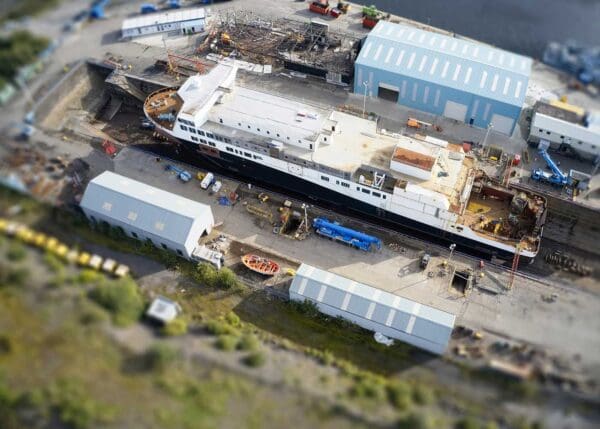01. Shipyard History
History
Long Beach Naval Shipyard was located on Terminal Island between the city of Long Beach and the San Pedro district of Los Angeles between 1940 and 1997.
Before World War II began, it was determined the U.S. Navy needed a large port of operation in the Los Angeles-Long Beach-San Pedro area. The shipyard’s initial main function was to perform routine and battle-damage repairs to naval ships. In 1946, the Long Beach Naval Shipyard was established as a homeport for Pacific Fleet ships, providing port facilities, fleet support personnel and recreational facilities most notably during WWII, the Korean War and the Vietnam War.
Between 1965 and 1970, 140 ships and 40,000 personnel were homeported at Long Beach. By 1990, those numbers declined to 38 ships, including the battleships USS Missouri and USS New Jersey, and 16,000 sailors.
The shipyard closed in 1997 under the Defense Base Closure and Realignment Act. After the closure, the Port of Long Beach constructed and currently operates one of the largest and most modern container terminals in the world.
Long Beach Naval Shipyard History at a Glance
- Other Names: Naval Shipyard Long Beach, U.S. Naval Dry Docks
- Location: Terminal Island between the city of Long Beach and the San Pedro district of Los Angeles
- Owner(s): City of Long Beach, Federal Government
- Years of Operation: 1940 – 1997
- Wartime Operations: World War II (WWII), Korean War, Cold War and the Vietnam War
- Number of Employees: More than 16,000 workers in 1945
- Size of Shipyard: 563 acres
- Noteworthy Ships: USS New Jersey, USS Missouri, USS Kearsarge
- Noteworthy Personnel: Captain George Fink
- Types of Ships Built/Serviced: Aircraft carriers, destroyers, battleships
Many workers at Long Beach Naval Shipyard were potentially exposed to asbestos. Workers’ loved ones may have also experienced secondhand exposure. As a result, many people developed asbestos-related diseases, such as asbestosis, asbestos lung cancer and pleural and peritoneal mesothelioma. People who developed an asbestos-related disease may be eligible for compensation.
Notable Ships Built and Repaired
In operation for more than five decades, the Long Beach Naval Shipyard was responsible for the repair and overhaul of hundreds of ships that participated in training exercises and battles across the globe. Some of these ships were made famous for their wartime efforts, even hosting U.S. presidents for important celebratory events.
Asbestos use was at an unprecedented high during many of the years Long Beach Naval Shipyard was active. The use of asbestos during this time put workers and crewmen all over the country at risk of developing asbestos-related diseases.
USS New Jersey
The battleship USS New Jersey was launched in 1942 by the Philadelphia Naval Shipyard. In 1944, she joined WWII efforts in the Pacific against Japan. She had two tours during the Korean War in 1951 followed by a period of training.
Her third war was the Vietnam War, for which she was fitted with improved electronics, a helicopter landing pad and tailored for use as a heavy bombardment ship. She traveled to her new home at Long Beach Naval Shipyard for training. After her first tour, she returned to Long Beach. In 1969, it was determined she would be deactivated. USS New Jersey was recommissioned at Long Beach Naval Shipyard in 1982 where she was modernized. Decommissioned for a final time in 1991, she is now a museum in Camden, New Jersey.
During the years the USS New Jersey was built and in service, asbestos was a common material used for shipbuilding and modernization. Many workers and crewman spent their time on the USS New Jersey, putting them at risk of developing mesothelioma.
USS Missouri
The battleship USS Missouri was constructed at the Brooklyn Naval Shipyard. She fought in WWII against Japan beginning in 1945, including the invasion of Iwo Jima, the bombarding of Okinawa and raids in Tokyo and Muroran, Hokkaido.
In 1946, the USS Missouri spent time in the Mediterranean in an effort to assist Greece and Turkey against Russia’s subversion. For the next several years, the USS Missouri was sent on training missions. In 1950, she joined the Korean War efforts. She was decommissioned in 1955 and recommissioned in 1986 for the Cold War. She conducted fleet operations training before departing on a circumnavigation of the world followed by several more years of training. In 1990, she joined Operation Desert Storm. Finally, in 1991, she was deactivated at Long Beach Naval Shipyard and decommissioned in 1992. She is now a museum and memorial open to the public at Pearl Harbor.
During her very long and active life, the USS Missouri made many stops at Long Beach Naval Shipyard. During this time, asbestos use was common in shipyards and on ships. The use of asbestos put her crew members at risk of asbestos-related diseases, as well as laborers who worked on her during these stops.
02. Shipyard Asbestos Use
Asbestos Use at Long Beach Naval Shipyard
Asbestos has properties ideal for building ships. It is highly resistant to heat, fire and physical breakdown. Thus, shipbuilders used asbestos to decrease fire and combustion risks associated with heavy, dangerous equipment.
Long Beach Naval Shipyard was active during 1940 – 1997. During this time, asbestos use was very common. At Long Beach Naval Shipyard, asbestos was used as insulation in walls, boilers, incinerators and around pipes. As a result, workers came in contact with many products that put them at risk of asbestos-related diseases.
Asbestos Exposure at Long Beach Naval Shipyard
Long Beach Naval Shipyard bustled with the activity of private citizens and military personnel. With the amount of asbestos in shipyards and ships, U.S. Navy veterans faced frequent exposure. Civilian workers and visitors also faced asbestos exposure risk. Before the 1980s, any shipyard visitor faced potential asbestos exposure and the risk of developing malignant mesothelioma cancer.
Maintenance workers on aircraft carriers, destroyers and battleships faced the same risks. Poor ventilation on ships combined with pervasive asbestos use made exposure common. For example, plumbers and pipefitters were exposed through the normal duties of their jobs.
Asbestos use all but stopped before the 1980s. However, people can still be exposed at shipyards when working on ships maintained or built pre-1980. Various shipyard duties, including sanding or sawing pipes for installation, exposed workers to asbestos.
03. Asbestos Lawsuits
Asbestos Lawsuits and Settlements
Anyone who was onsite at Long Beach Naval Shipyard and came in contact with asbestos products is at risk of developing asbestos diseases such as mesothelioma and asbestos cancer. These individuals have many options for compensation.
Asbestos product manufacturers are responsible for exposing people to asbestos. The legal status of these companies can affect what compensation is available to victims. Mesothelioma lawyers can help victims determine if a lawsuit, settlement, VA claim and/or trust fund claim (or a combination of these) is the best compensation option.
Holding Asbestos Companies Responsible
Some asbestos product manufacturers remain in business today. This means these companies have not filed for bankruptcy and victims can file lawsuits against the company. Lawsuits may result in compensation through verdicts or settlements.
For example, people were wrongfully exposed to asbestos at Long Beach Naval Shipyard because of pumps supplied by FMC Corporation that included packing or gaskets containing asbestos. These pumps put pipefitters, steamfitters, mechanical engineers and other workers at risk of developing asbestos-related diseases such as mesothelioma.
Another viable pump supplier, Buffalo Pumps, Inc., put workers and crew members at risk of asbestos exposure through their products. The pumps were regularly supplied to ships and shipyards during WWII, putting thousands at risk of asbestos exposure at Long Beach Naval Shipyard at this time and for years to come.
Victims have filed successful lawsuits against these companies.
04. Filing Asbestos Claims
Asbestos Company Trusts
Some companies who wrongfully exposed people to asbestos turned to bankruptcy to handle asbestos-related claims. Since the 2000s, more than 100 companies have taken this approach. Many of these asbestos companies created trust funds in order to compensate victims of asbestos-related diseases.
Shipyard workers developed asbestos-related diseases after working with asbestos products. One compensation option for these individuals is to file a mesothelioma claim with that asbestos company’s trust.
Asbestos Company Trust Funds and Eligible Years of Employment
The following companies provided asbestos products to Long Beach Naval Shipyard. After facing many asbestos lawsuits and exposing innocent people to asbestos, these companies filed for bankruptcy and created trusts to pay victims. If an individual worked at Long Beach Naval Shipyard and developed a disease such as mesothelioma, they may be able to file a claim against these companies’ trusts.
| Asbestos Trust Funds & Eligible Years of Employment | ||
|---|---|---|
| Asbestos Company Name | Eligibility Start Date | Eligibility End Date |
| AC&S Inc. | 9/14/1960 | 12/31/1982 |
| A.P. Green | 1/1/1963 | 1/2/1968 |
| Armstrong WI Trust | 10/26/1961 | 12/31/1982 |
| Babcock & Wilcox | 4/1/1900 | 12/31/1982 |
| Burns and Roe | 1/1/1968 | 12/31/1982 |
| Combustion Engineering | 1/1/1942 | 12/31/1982 |
| Fibreboard | 1/1/1930 | 12/31/1982 |
| JT Thorpe | 6/1/1945 | 7/31/1957 |
| Keene Corp. | 1/1/1920 | 12/31/1982 |
| Owens Corning | 1/1/1930 | 12/31/1982 |
| Pittsburgh Corning | 7/1/1962 | 12/31/1982 |
| Plant Insulation | 1/1/1952 | 12/31/1982 |
| Thorpe Insulation | 5/10/1948 | 12/31/1979 |
| United States Gypsum | 1/1/1963 | 1/2/1968 |




